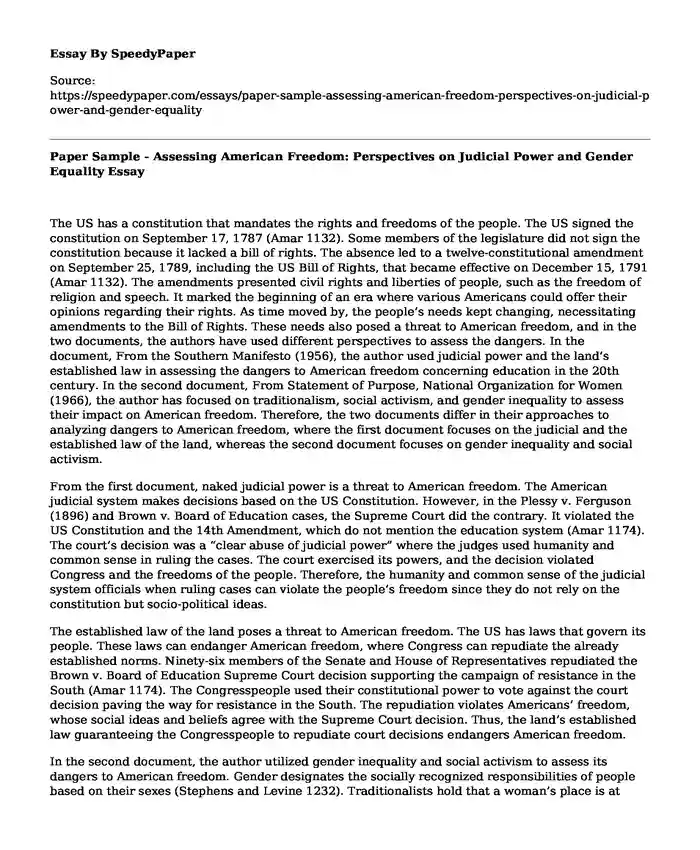
| Type of paper: | Essay |
| Categories: | Gender United States Constitution |
| Pages: | 3 |
| Wordcount: | 744 words |
The US has a constitution that mandates the rights and freedoms of the people. The US signed the constitution on September 17, 1787 (Amar 1132). Some members of the legislature did not sign the constitution because it lacked a bill of rights. The absence led to a twelve-constitutional amendment on September 25, 1789, including the US Bill of Rights, that became effective on December 15, 1791 (Amar 1132). The amendments presented civil rights and liberties of people, such as the freedom of religion and speech. It marked the beginning of an era where various Americans could offer their opinions regarding their rights. As time moved by, the people’s needs kept changing, necessitating amendments to the Bill of Rights. These needs also posed a threat to American freedom, and in the two documents, the authors have used different perspectives to assess the dangers. In the document, From the Southern Manifesto (1956), the author used judicial power and the land’s established law in assessing the dangers to American freedom concerning education in the 20th century. In the second document, From Statement of Purpose, National Organization for Women (1966), the author has focused on traditionalism, social activism, and gender inequality to assess their impact on American freedom. Therefore, the two documents differ in their approaches to analyzing dangers to American freedom, where the first document focuses on the judicial and the established law of the land, whereas the second document focuses on gender inequality and social activism.
From the first document, naked judicial power is a threat to American freedom. The American judicial system makes decisions based on the US Constitution. However, in the Plessy v. Ferguson (1896) and Brown v. Board of Education cases, the Supreme Court did the contrary. It violated the US Constitution and the 14th Amendment, which do not mention the education system (Amar 1174). The court’s decision was a “clear abuse of judicial power” where the judges used humanity and common sense in ruling the cases. The court exercised its powers, and the decision violated Congress and the freedoms of the people. Therefore, the humanity and common sense of the judicial system officials when ruling cases can violate the people’s freedom since they do not rely on the constitution but socio-political ideas.
The established law of the land poses a threat to American freedom. The US has laws that govern its people. These laws can endanger American freedom, where Congress can repudiate the already established norms. Ninety-six members of the Senate and House of Representatives repudiated the Brown v. Board of Education Supreme Court decision supporting the campaign of resistance in the South (Amar 1174). The Congresspeople used their constitutional power to vote against the court decision paving the way for resistance in the South. The repudiation violates Americans’ freedom, whose social ideas and beliefs agree with the Supreme Court decision. Thus, the land’s established law guaranteeing the Congresspeople to repudiate court decisions endangers American freedom.
In the second document, the author utilized gender inequality and social activism to assess its dangers to American freedom. Gender designates the socially recognized responsibilities of people based on their sexes (Stephens and Levine 1232). Traditionalists hold that a woman’s place is at home, helping with motherhood and childcare (Stephens and Levine 1234). However, times have changed, and there is a need for equality between the sexes. The National Organization for Women (NOW) started a movement to fight for women’s freedom in US society because of women’s declining societal position in the 1950s and 1960s. Therefore, the second document has used the differences in gender to illustrate their potential outcomes as dangers to American freedom.
Conclusion
In conclusion, the two documents differ in how they have assessed the dangers to American freedom. The first document prioritized the land’s established law and the judicial power to explain how the court and Congress's decisions can affect people’s freedom. In the second document, gender inequality becomes a threat to American freedom when women start social activism demanding equality. Dangers to freedom are also evident in Kenya, an East African country, based on gender equality in the 21st century. The government implemented the two-thirds gender rule, but the policy remains a mystery since women remain under-represented.
Works Cited
Amar, Akhil Reed. “The Bill of Rights as a Constitution.” Yale Law Journal (1991). www.jstor.org/stable/796690
Stephens, Nicole M., and Cynthia S. Levine. “Opting out or denying discrimination? How the framework of free choice in American society influences perceptions of gender inequality.” Psychological science, 2011. journals.sagepub.com/doi/abs/10.1177/0956797611417260.
Cite this page
Paper Sample - Assessing American Freedom: Perspectives on Judicial Power and Gender Equality. (2024, Jan 17). Retrieved from https://speedypaper.com/essays/paper-sample-assessing-american-freedom-perspectives-on-judicial-power-and-gender-equality
Request Removal
If you are the original author of this essay and no longer wish to have it published on the SpeedyPaper website, please click below to request its removal:
- Essay Sample for Free: Political Reasoning Behind the Public Policy
- Essay Sample on Duties towards Compatriots and Non-Compatriots
- Free Essay on Customs and Border Protection Operations
- Essay Sample on the Role of Sanctuary Cities and Trump's Policies on the Immigration
- Supply Chain Logistics Management Case Study
- The Productivity Puzzle. Paper Example
- Essay Sample on Henig and Johnson's Description on Gender Experience
Popular categories




